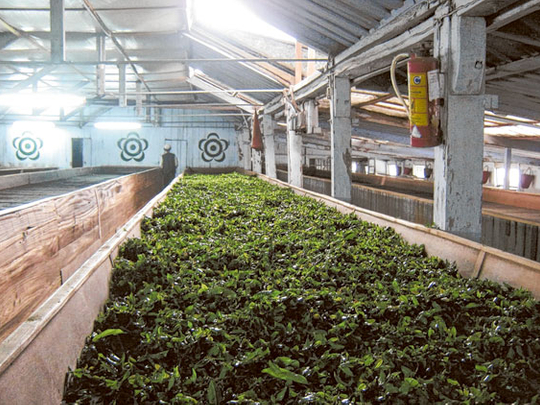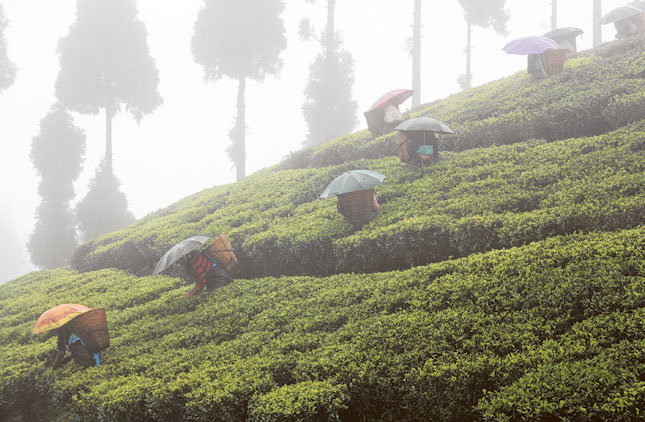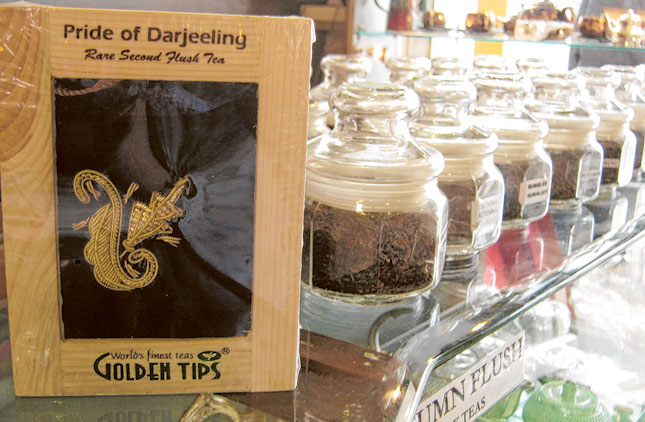
“If an accident’s written in your forehead, it will happen. You cannot stop it,” my driver Biren tells me in what he assumes is a reassuring manner. I wipe the sweat off my brow (fervently hoping nothing is written on my forehead) and offer a prayer to the universe for the hundredth time as our jeep goes down an alarmingly narrow road, hugging a steep hillside in Darjeeling district in the Himalayas.
I have asked Biren several times in the past two hours about the frequency of accidents in the hills. My teeth have been permanently on edge in tandem with the jeep’s brakes, which have been jammed on all the time since the hills began. My nerves were on edge.
Along the way, we passed a car which had begun sliding downhill. The driver had rushed out, plucked chunks of fallen debris off the hill and shoved them under the tyres to stop the slide. As we round a curve, I see what lies ahead with some trepidation — a curving dirt track sloping down at an angle of almost 90 degrees. “That’s Selim Hill,” said Biren, pointing to a white bungalow at the edge of the hill. That is it. I would rather go down on my trustworthy feet the rest of the way, I tell a protesting Biren and set off for Selim Hill.
I am here in Kurseong, in the middle of the Eastern Himalayas, on the trail of Darjeeling tea. It is monsoon time — when plucking is at its peak as the tea bushes are budding profusely due to the rain. Rain brings landslides in these areas — the newspapers in Kolkata had been full of reports about landslides, accidents and roads being cut off. I had also read that Darjeeling’s neighbouring state, Sikkim, was cut-off from the rest of the country due to road blockages. We had to take an alternative road when we heard the main road to Kurseong was blocked.
Tea tours
My first stop on the tea trail was Selim Hill Tea Estate, a heritage bungalow dating back to the British era that had been converted into a stopover on the tea tourism trail. In a savvy move, the state-run Tea Board along with some innovative tourism promoting organisations such as HELP Tourism, started the concept of tea tourism.
Modelled along the lines of similar tourism in the West, it includes some of the most scenic destinations in India — the rolling Himalayan foothills of Darjeeling and Dooars, and also stays at some of the most atmospheric, Raj-era estates in India. Guests get to tour tea estates and check out first-hand the process of tea plucking and tasting. Since the surrounding landscape consists of some beautiful Himalayan territory, one can also avail of nature walks, birdwatching, trekking, rafting, among other things.
You can take your pick from the upscale ones such as Glenburn Tea Estate and Boutique Hotel (dating to 1859), selected as one of the best 101 hotels of the world by the “Tatler Travel Guide”, to the comfortable homestays on the Makaibari tea estate, where you get to stay in tea workers’ houses.
At Selim Hill Tea Estate, the sun is setting — bathing the hills in an amazing pink and orange glow as I walk in through the swing doors of the bungalow. My room has a cast-iron fireplace, an attached bath and windows overlooking the garden and hills. The living room area has windows along all the walls and shelves full of old and new books and magazines. The resident chef Neema Subbah is on hand to rustle up great food — from pancakes to aloo parathas.
I settle for a bowl of steaming vegetable momos in soup. My dinner companion is the colourful estate manager, Rohit Singh Rathore. He has a BSc in agriculture and was formerly with the Indo-Tibetan Border Police. He regales me with tales of wildlife in the area — bears, leopards, snakes (“I caught a king cobra recently, the capture’s up on YouTube”), film shoots on the estate (“they nearly shot the Priyanka Chopra-Ranbir Kapoor film ‘Barfi’ here. I wanted the part of the estate manager”) and a list of visitors to the area (“who was that freedom fighter ... yes, Subhash Bose, his elder brother used to live here and so did Rabindranath Tagore”), before moving on to tea.
“Darjeeling district has more than 80 tea estates and every valley produces tea with a distinctive taste,” Rathore says, as he gives me a crash course on Darjeeling tea. “The altitude, the moisture, the wind direction — everything contributes to the unique taste.”
The taste is why Darjeeling tea is considered to be among the best in the world. Braving hairpin drives on wet roads, and possible extermination through landslides, may seem too much for a cup of tea. But then Darjeeling tea is considered the best. It fetches record prices at auctions worldwide. An organic muscatel variety from here recently sold for Rs50,000 (Dh3,355) a kilogram at an auction in Beijing.
A colonial legacy
I read somewhere that Selim Hill Tea Estate was set up by a British planter (enigmatically named “Mr Henry”) sometime in 1800. Some of his descendants had visited the estate recently, with his old pictures of Henry at the bungalow. The Darjeeling tea industry is a colonial legacy. So is the town of Darjeeling. It is one of the several former hill stations set up by the British to escape from the heat of the plains. Across all these hill stations, botanical gardens were set up by the British to test new cash crops. It is believed that the British brought tea to Darjeeling sometime in mid-1800s. They used seeds from China (Camellia sinensis) for experimental tea planting. It was a success and soon tea brought in good revenues as an export commodity in Britain and new colonies.
Most of the tea in Darjeeling comes from China bushes, many of which can qualify for heritage status. At Selim Hill, the bushes date back to 1860.
Today Darjeeling produces nearly 10 million kilograms of tea annually. Of this, 40 per cent is exported. The rest are called “rain teas”, and do not get good prices in the global market. The entire district seems to be oriented towards tea.
As I drive up the hills, plantations and signs of tea estates dot the countryside. Driving into Darjeeling town, small and big shops all sell the commodity that seems to have put Darjeeling on the world map. At the famous Nathmulls tearoom on Darjeeling town’s Chowrasta, I am invited to taste from a wide variety of tea stored in glass jars. A 60-gram packet of Adam’s Glee Flowering White Tea sells for Rs1,035. A 125-gram packet of Pride of Darjeeling Rare Second Flush (limited production) sells for Rs1,590. I find traces of the colonial hangover at Glenary’s, a century-old café which serves up a legendary high tea complete with scones and other teatime treats.
Tea production and price fluctuates according to climate and political conditions in Darjeeling. The district has suffered from political unrest for decades, mostly due to the demand for separate statehood. Another reason production has taken a hit has been a series of ongoing labour movements by plantation workers to improve their work conditions.
A tea by any other name
Here is an interesting fact I picked up while on my tea trail — most of the Darjeeling tea sold in the international markets has only a small portion of the authentic product in packets that often contain blends of teas from many other origins. Now, due to the efforts of the Indian government and the Tea Board, Darjeeling Tea has been given the tag of protected geographical indication (PGI) product from India. As per the registration, teas sold under the name of “Darjeeling Tea” will have to be 100 per cent Darjeeling tea — that is made in the district.
Few people know that Darjeeling tea is not one beverage but many. Around 87 tea estates spread over 7,082 hectares in this district (some located at an altitude of 5,000 metres above sea level) — each producing its own unique variety of tea.
Take the well-known Makaibari tea estate, for instance, my second stop on the tea trail. As opposed to the big company-run gardens such as Goodricke and Castleton, it is a single tea estate which has been run by the Banerjee family since the 1840s when it was founded by G. C. Banerjee. Today it is helmed by his great-grandson Swaraj or Rajah Banerjee. Or “The Rajah of Makaibari”. He is a flamboyant figure often seen in khakis and a hat.
Rajah introduced organic farming to Makaibari in 1988. After a few years, Makaibari became the first Demeter-certified biodynamic tea estate in the Himalayas (Demeter International is the largest certification organisation for biodynamic agriculture used in over 50 countries). “When you are drinking the tea, it is the spirit of Makaibari,” Rajah says.
About 70 per cent of the estate’s tea is exported to Germany, France, the United Kingdom, the United States and Japan. Makaibari’s most precious produce is the Silver Tips Imperial tea — a prize-winning and record-breaking tea harvested using only the buds and hand-rolled leaf.
It was the official tea at the Beijing Olympics, says my guide on the Makaibari tour, Nayan Llama. This 28-year-old with a BCom degree takes me through the plant, pointing out the withering room where freshly plucked tea leaves are evenly spread on troughs, through which hot and cold air are blown in to remove moisture. After that, the leaves are loaded into rollers to be twisted. The leaf is then spread in thin layers in a cool room to be fermented. This makes the tea develop a unique flavour and aroma. Last, it is taken to a dryer.
The process differs according to the kind of tea produced — for instance, some tea will not be fermented, some will be hand-rolled, some will only use tips and not leaves.
The last stop on my Makaibari tea estate journey is the tasting room with an array of neatly labelled jars. The jars sport a medley of bewildering alphabets — SFTGFOP (Super Fine Tippy Golden Flowery Orange Pekoe), FTGFOP (Fine Tippy Golden Flowery Orange Pekoe), TGFOP (Tippy Golden Flowery Orange Pekoe) FTGBOP (Fine Tippy Golden Broken Orange Pekoe) and so on, till the last and lowest in the rung — dust.
Dust is what you generally find in a lot of mass-produced tea bags. Nayan weighs out a teaspoonful, steeps it in boiling water and strains the tea into teacups. Tea tasting is complicated. You are supposed to exhale strongly into the tea leaves first — “breathe into it to release the flavours” and then smell the tea. Then sip the liquid, inhaling sharply.
Made by hand
The style of plucking is essential to the making of Darjeeling tea. It is one of the few tea-growing regions in the world that still remains faithful to the higher-cost “orthodox” tea production method which makes tea the labour-intensive, hand-plucked way. Only the smallest shoots, comprising two leaves and a bud, are plucked. Sometimes it takes 20,000 such individually plucked shoots to produce just one kilogram of tea.
I am taken on a tour of the tea gardens by Dawa Lama, a self-employed guide and volunteer working with Makaibari homestays. Workers begin their shifts early in the morning, when the overnight dew is still present. Only the most tender leaves are plucked. Pluckers are so quick and skilful that it is often impossible to follow the motion of their hands and fingers as they pluck. I meet Lila Raini, who is putting on her gear and going out to work in the post-lunch shift. She is about 55 to 56 years old, she says, and has been working since the age of 10 in tea plantations. Her gear is primitive — she ties on a blue plastic sheet with rope around her waist, much like an apron. Is that for the rain? I ask Dawa. No, that is to protect her clothes from getting ripped by the bushes, he says. Lila puts on a pair of gumboots to protect her from leeches. Last, the belt attached to the bamboo tea basket goes around her head, and the basket is perched on her back. Lila works eight hours a day and gets a daily wage of Rs90.
Storm in a tea cup
Since the process is so labour-intensive, production costs can be high. And plantation labour is increasingly difficult to get nowadays. “I have to employ casual labour during flush time,” Rathore says. This is not surprising as work conditions can be dismal — workers such as Lila spend most of their time under the scorching sun or getting soaked in the rain. A tea-leaf picker spends almost all working hours standing. And to cap all this, workers are not entitled to the land they have tilled for generations. Another factor driving youth away from tea garden work is increasing level of education.
A few people have come back to find ways to better the lives of tea workers. Situated in the centre of Darjeeling town — the Chowrasta — is the slick and ethnic Life N Leaf shop. It sells products made by tea workers — honey, bamboo products, woven bags and scarves. “We started as an initiative to strengthen local people’s capacity, empower them and address their issues and concerns,” founder Suman K. Rai says. “We look at ways to diversify tea workers’ livelihood and sources of income so they are not dependant on just tea.”
Suman grew up in a tea garden. “My grandfather was a tea worker who rose to the status of a munshi. He was very conscious of the fact that the tea industry would not be good for family or society. He gave my father a good education. My father was a clerk and rose to a management-level position in a tea garden. He was also particular about giving us a good education. In or tea garden, I was one of the first to do a masters. This was in 1992, and tea gardens have been around for hundreds of years,” he smiles.
Suman thinks the tea industry bigwigs have to rethink and re-strategise. “One must work towards a win-win solution,” he says. He suggests, among other things, providing counselling to youth and better education as well as employment benefits. He cites the example of some tea estates in Kerala where workers get shares in the company. Rathore, the manager at Selim Hill, had echoed the same thought. “It is tough to get labour nowadays and unless something is done to improve the situation, a time will come when you won’t get any workers. Youngsters are leaving the place for more money. They are going outside for further studies. Once they’ve got degrees, who will want to come back? If these issues are not addressed soon, there will be no Darjeeling tea left anymore.”
As I wind my way down the hills next day, the scenery is more than just a picture postcard. But I leave reminded of all the effort, history and complex social ties that go into making our morning cuppa so special.
Anuradha Sengupta is a writer based in Mumbai.





